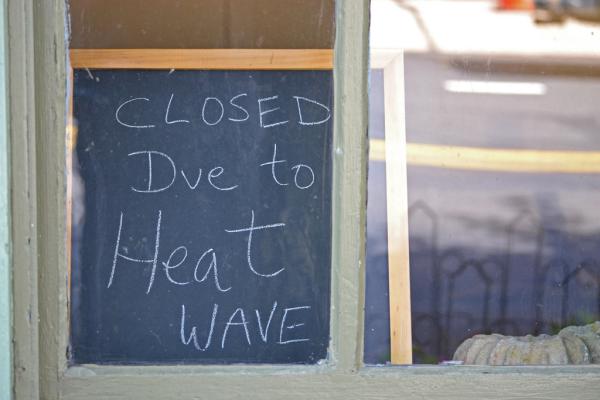As extreme heat grips several areas of the country, Tuesday's high temperature in Palm Springs, California was a staggeringly brutal and record-breaking 121 degrees. And a bit north in the state, Death Valley, according to the National Weather Service, came in at 127 degrees, eclipsing its previous all-time record of 126 set 102 years ago.
As temperatures have climbed to a record-setting 114 in Waco, Texas on Monday, while Southern Arizona was suffocated yesterday with ranges from 112 to 119 degrees, increasingly millions of U.S. residents are having to endure life-threatening, summertime heat. In fact, the NWS recently stated on its website that "Nationwide, heat is the #1 weather-related killer."
Yet, while there have been at least 80 heat-related deaths in the last two weeks from Japan's heat wave, where air-conditioning is uncommon, and an estimated 70 fatalities have been recorded in the Canadian province of Quebec, by comparison, heat-related deaths in the Southwestern U.S. are relatively low.
In the Los Angeles area, where temperatures have reached 90 to 102 in the coastal plains and up to 108 in the valleys, there have been six reported deaths in Riverside County. Most were elderly, including "a 91-year-old from Riverside who died of prolonged heat exposure in a home without cooling measures," according to a county official speaking to the Los Angeles Times. And in Maricopa County in Arizona, there have been five confirmed heat-related fatalities so far this year.
 The statistics would suggest that despite these insane temperatures, we are doing a fairly good job of safeguarding ourselves as well as making use of air-conditioning whenever possible. And while AC is more accessible because it's relatively cheap and more affordable, it appears a connection can be drawn to the availability of lower-cost natural gas. The United States has an abundance of it now, and that ample supply has driven down energy costs and cut pollution.
The statistics would suggest that despite these insane temperatures, we are doing a fairly good job of safeguarding ourselves as well as making use of air-conditioning whenever possible. And while AC is more accessible because it's relatively cheap and more affordable, it appears a connection can be drawn to the availability of lower-cost natural gas. The United States has an abundance of it now, and that ample supply has driven down energy costs and cut pollution.
"The reality is that emissions have gone down," wrote Hank Campbell in 2014 just prior to becoming President of the American Council on Science and Health. "The big change," which began early this century, "came because America switched to natural gas, and that was thanks to science and the free market. Due to that switch, energy emissions haven't looked this good in 20 years. Coal emissions haven't looked this good in 30 years."
What makes this year's U.S. death toll look relatively low is that the Centers for Disease Control and Prevention report that, on average, 673 heat-related deaths occur nationally per year. It recorded 8,081 such fatalities between 1999 and 2010, and that, identified by location the CDC states that "[h]eat-related deaths occurred most frequently in urban areas (81%), and the three states with the highest burden, Arizona, Texas and California accounted for 43% of all heat-related deaths."
The nation's natural gas strategy, which makes air conditioning more accessible through affordable pricing, looks even better when compared to drastic heat events elsewhere when AC either was neither available, or used.
In the summer of 2003, an out-of-the-ordinary heat wave in France took the lives of nearly 15,000 people, an incredible total, according to the French National Institute of Health and Medical Research. The prolonged, oppressive weather included eight consecutive days with temperatures of more than 100°F
"The bulk of the victims — many of them elderly — died during the height of the heat wave, which brought suffocating temperatures of up to 104 degrees in a country where air conditioning is rare," the Associated Press reported at the time. "Others apparently were greatly weakened during the peak temperatures but did not die until days later."
Since most heat-associated deaths occur in urban areas, it makes complete sense for cities to continually take strides to combat high temperatures. Those measures can include planting trees and painting over black-top roofs to make them white, a color to reflect (and not absorb) sun rays.
City residents can also take added precautions, like knowing where cooling centers are located and visiting them, and creating an action plan in the event of an electrical blackout and power loss. Here are other ways to keep yourself cool and to guard against heat-related illness.




